Design and Dynamic Analysis of the Wire-Line Coring Robot for Deep Lunar Rocks
Abstract
1. Introduction
2. Design of the Wire-Line Coring Robot for Deep Lunar Rocks
2.1. Coring Executor
- After the wire-line coring robot is placed on the moon, the exploding bolt works to separate the WSC robot from the coring executor, and the X-Z linear displacement robot grabs the WSC robot and moves it to the center while loosening the cable of the rope winder;
- The X-Z linear displacement robot releases the WSC robot, and then the rope winder slowly lifts the WSC robot down the through-hole by the cable. After dropping the specified amount of cable, the WSC robot begins coring work. When this coring phase is completed, the X-Z linear displacement robot grabs the WSC robot to fix the position;
- The X-Z linear displacement robot and the fidelity chamber combine their movements to transport the WSC robot to the position corresponding to the number of this full coring tube. Then, the full coring tube is unloaded and installed into the empty coring tube by a Z-axis displacement unit. Repeat steps 2 and 3 until the desired mission target is completed.
2.2. Wire-Line Self-Excavating Coring Robot
3. Dynamic Analysis of the WSC Robot
3.1. Maximum Support Force Analysis of the Anchor Module
3.2. Dynamic Analysis of the Impact Module
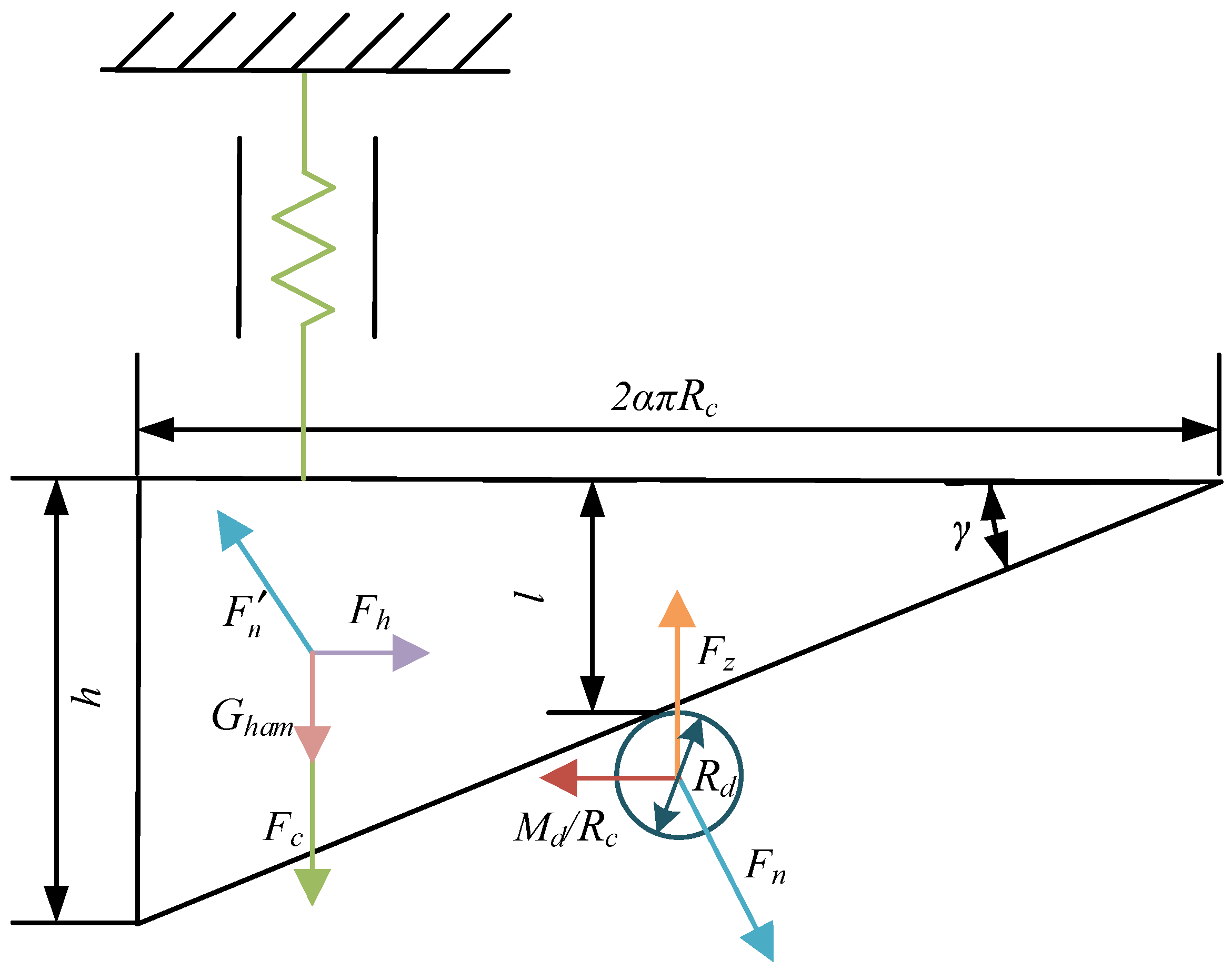
4. Conclusions
Author Contributions
Funding
Institutional Review Board Statement
Data Availability Statement
Conflicts of Interest
References
- Zhang, T.; Xu, K.; Yao, Z.X.; Ding, X.L.; Zhao, Z.; Hou, X.Y.; Pang, Y.; Lai, X.M.; Zhang, W.M.; Liu, S.T.; et al. The progress of extraterrestrial regolith-sampling robots. Nat. Astron. 2019, 3, 487–497. [Google Scholar] [CrossRef]
- Bar-Cohen, Y.; Zacny, K. Drilling in Extreme Environments: Penetration and Sampling on Earth and other Planets; Wiley-VCH: Berlin, Germany, 2009. [Google Scholar]
- Badescu, V.; Zacny, K. Inner Solar System: Prospective Energy and Material Resources; Springer: Cham, Switzerland, 2015. [Google Scholar] [CrossRef]
- Zhang, T.; Wang, B.; Wei, H.; Zhang, Y.; Chao, C.; Xu, K.; Ding, X.; Hou, X.; Zhao, Z. Review on planetary regolith-sampling technology. Prog. Aeronaut. Sci. 2021, 127, 1–26. [Google Scholar] [CrossRef]
- Qiao, L.; Chen, J.; Xu, L.; Wan, S.; Cao, H.; Li, B.; Ling, Z. Geology of the Chang’e-5 landing site: Constraints on the sources of samples returned from a young nearside mare. Icarus 2021, 364, 114480. [Google Scholar] [CrossRef]
- Slyuta, E. Chapter 3—The Luna program. In Sample Return Missions; Longobardo, A., Ed.; Elsevier: Amsterdam, The Netherlands, 2021; pp. 37–78. [Google Scholar] [CrossRef]
- Jerde, E.A. Chapter 2—The Apollo program. In Sample Return Missions; Longobardo, A., Ed.; Elsevier: Amsterdam, The Netherlands, 2021; pp. 9–36. [Google Scholar] [CrossRef]
- Zhang, X.; Zhang, G.Q.; Xie, H.P.; Gao, M.Z.; Wen, Y.F. A Review of Sampling Exploration and Devices for Extraterrestrial Celestial Bodies. Space Sci. Rev. 2022, 218, 1–50. [Google Scholar] [CrossRef]
- Zhang, Y.L.; Zhang, T.; Wei, H.Y.; Liu, J.B.; Wang, W.; Yuan, X.Y.; Pang, Y.; Guan, Y.S.; Hou, X.Y.; Xu, K. Advances in Extraterrestrial Drilling Technology to Discover the Secrets Hidden Inside Celestial Bodies. Space Sci. Rev. 2022, 218, 1–46. [Google Scholar] [CrossRef]
- Liang, P.; Hou, X.; Zhang, K.; Zhang, K.; Deng, Z. The research and design of pneumatic multi-pipe deep lunar soil drilling device. In Proceedings of the 2016 IEEE International Conference on Mechatronics and Automation, Harbin, China, 7–10 August 2016; pp. 1379–1384. [Google Scholar] [CrossRef]
- Bogatcbev, A.; Koutcberenko, V.; Malenkov, M.; Matrossov, S. Developments of Track Locomotion Systems for Planetary Mobile Robots. IFAC Proc. Vol. 2004, 37, 153–158. [Google Scholar] [CrossRef]
- Magnani, P.G.; Re, E.; Ylikorpi, T.; Cherubini, G.; Olivieri, A. Deep drill (DeeDri) for Mars application. Planet. Space Sci. 2004, 52, 79–82. [Google Scholar] [CrossRef]
- Cannon, H.N.; Stoker, C.R.; Dunagan, S.E.; Davis, K.; Gómez-Elvira, J.; Glass, B.J.; Lemke, L.G.; Miller, D.; Bonaccorsi, R.; Branson, M.; et al. MARTE: Technology development and lessons learned from a Mars drilling mission simulation. J. Field Robot. 2007, 24, 877–905. [Google Scholar] [CrossRef]
- Li, P.; Zhang, H.; Jiang, S.Y.; Zhang, W.W. Analysis and Testing of Load Characteristics for Rotary-Percussive Drilling of Lunar Rock Simulant with a Lunar Regolith Coring Bit. Shock. Vib. 2017, 2017, 3012749. [Google Scholar] [CrossRef]
- Szwarc, T.J. Thermal Modeling of Coring and Drilling Operations for Solar System Exploration Applications. Ph.D. Thesis, Stanford University, Stanford, CA, USA, 2013. [Google Scholar]
- Marshall, J.P.; Hudson, T.L.; Andrade, J.E. Experimental Investigation of InSight HP3 Mole Interaction with Martian Regolith Simulant. Space Sci. Rev. 2017, 211, 239–258. [Google Scholar] [CrossRef]
- Zhang, W.; Li, L.; Jiang, S.; Ji, J.; Deng, Z. Inchworm Drilling System for Planetary Subsurface Exploration. IEEE/ASME Trans. Mechatron. 2020, 25, 837–847. [Google Scholar] [CrossRef]
- Zacny, K.; Bar-Cohen, Y.; Brennan, M.; Briggs, G.; Cooper, G.; Davis, K.; Dolgin, B.; Glaser, D.; Glass, B.; Gorevan, S.; et al. Drilling systems for extraterrestrial subsurface exploration. Astrobiology 2008, 8, 665–706. [Google Scholar] [CrossRef] [PubMed]
- Bar-Cohen, Y.; Zacny, K.; Badescu, M.; Lee, H.J.; Sherrit, S.; Bao, X.Q.; Freeman, D.; Paulsen, G.L.; Beegle, L. Auto-Gopher-2-Wireline Deep Sampler Driven by Percussive Piezoelectric Actuator and Rotary EM Motors. Adv. Sci. Technol. 2016, 100, 207–212. [Google Scholar]
- Heiken, G.H.; Vaniman, D.T.; French, B.M. Lunar Sourcebook, A User’s Guide to the Moon; Press Syndicate of the University of Cambridge: New York, NY, USA, 1991. [Google Scholar]
- Mitchell, J.K.; Houston, W.N.; Carrier, W.; Costes, N.C. Apollo soil mechanics experiment S-200. Arch. Dermatol. Syphilol. 1974, 53, 19740019219. [Google Scholar]
- Duke, M.; Woo, C.; Sellers, G.; Bird, M.; Finkelman, R. Genesis of lunar soil at Tranquillity Base. In Proceedings of the The Apollo 11 Lunar Science Conference, Houston, TX, USA, 1 January 1970; pp. 347–361. [Google Scholar]
- Mitchell, J.; Houston, W.; Scott, R.; Costes, N.; Carrier III, W.; Bromwell, L. Mechanical properties of lunar soil: Density, porosity, cohesion and angle of internal friction. In Proceedings of the The Third Lunar Science Conference, Houston, TX, USA, 1 January 1972; pp. 3235–3253. [Google Scholar]
- Pham, K.D.; Zhao, W.; Zmuda, H.; Sun, H.; Jia, Q.; Cox, J.L.; Meyer, G.J.; Zhang, Y. Mechanical analysis about the spherical mobile robot on the moon environment. In Sensors and Systems for Space Applications IV; SPIE: Orlando, FL, USA, 2011. [Google Scholar] [CrossRef]
- Yang, Z. Research on Impact Crushing in Luna Soil Sampling Based on ANSYS/Ls-Dyna Numerical Simulation Master; Harbin Institute of Technology Harbin: Harbin, China, 2019. [Google Scholar]




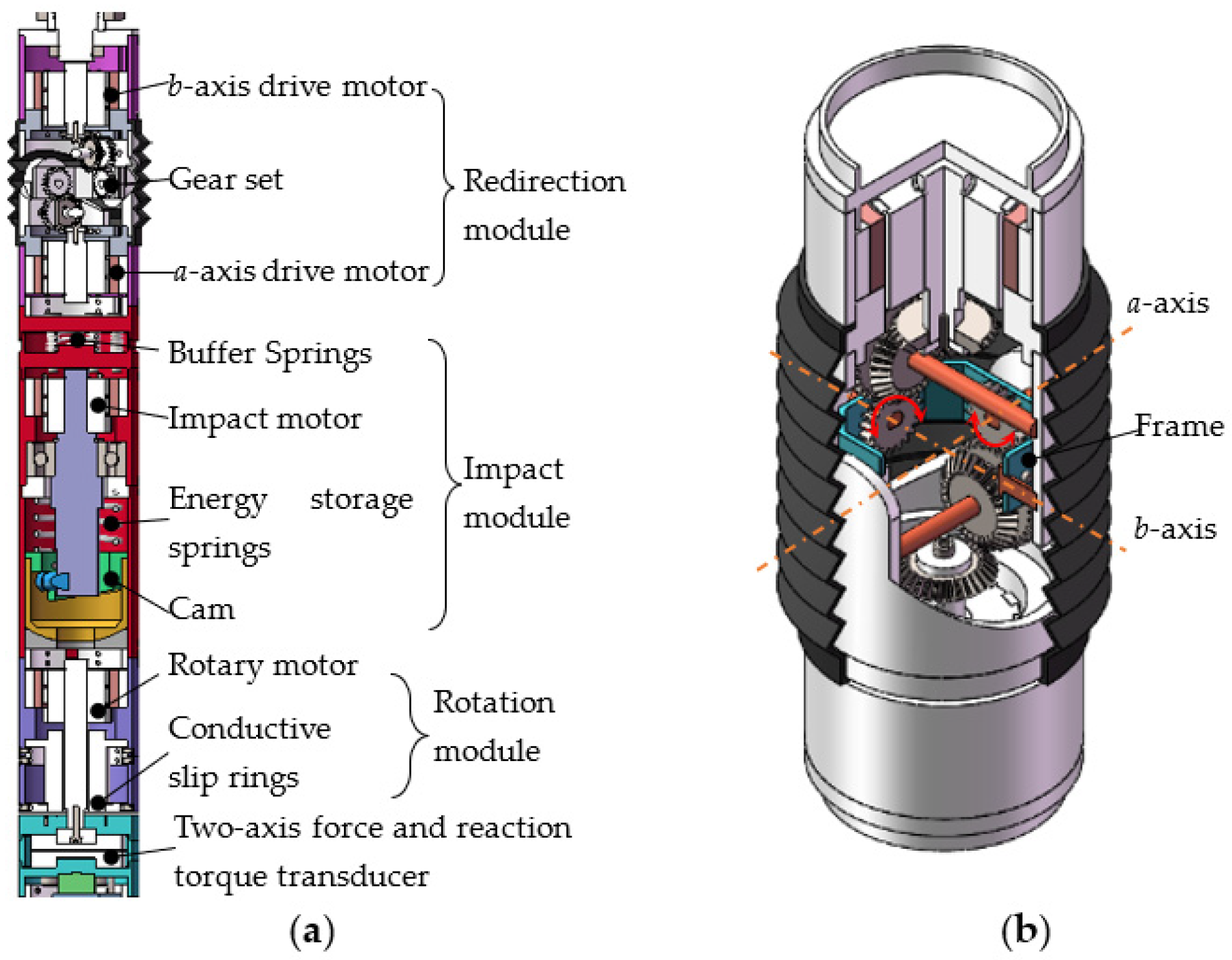
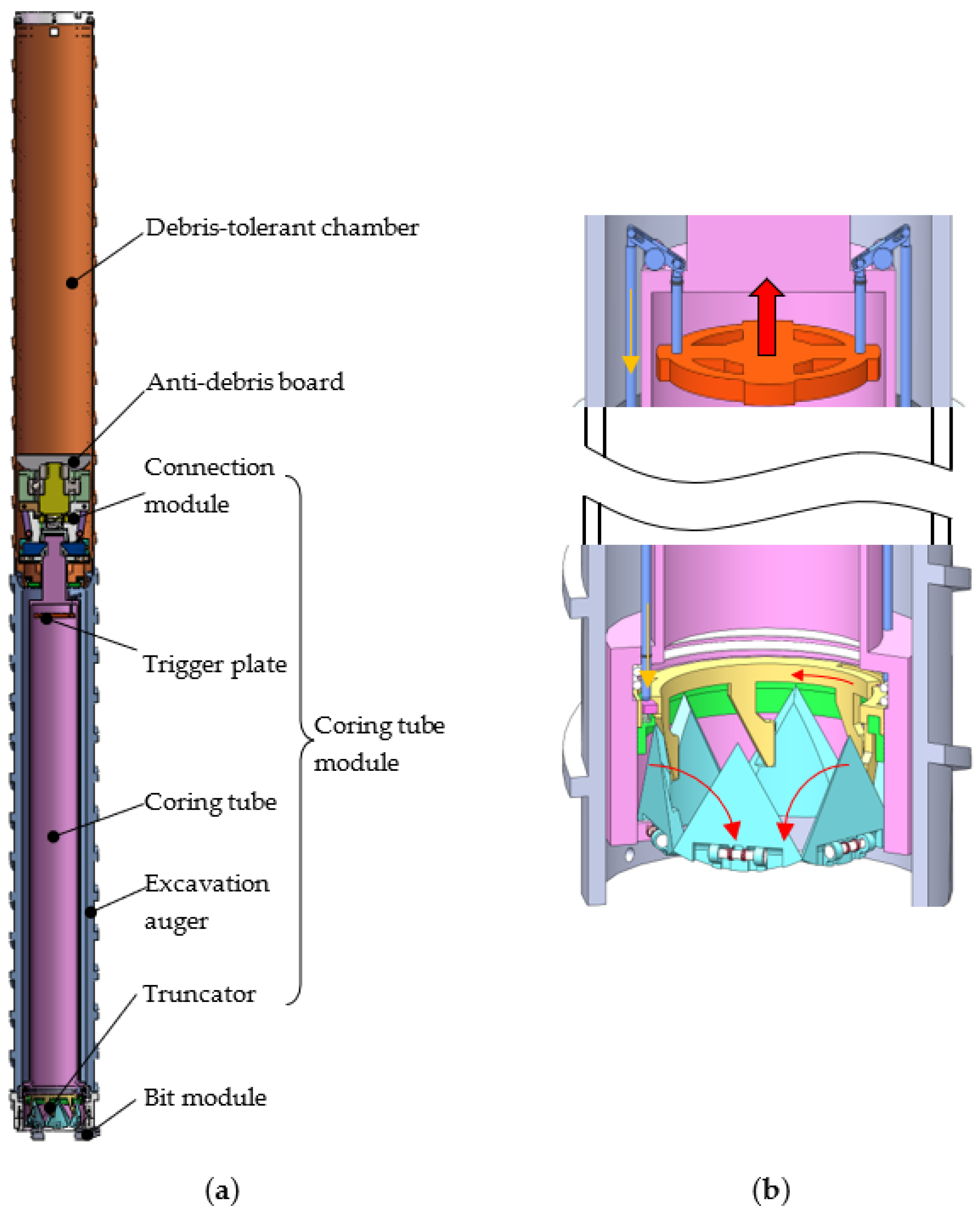

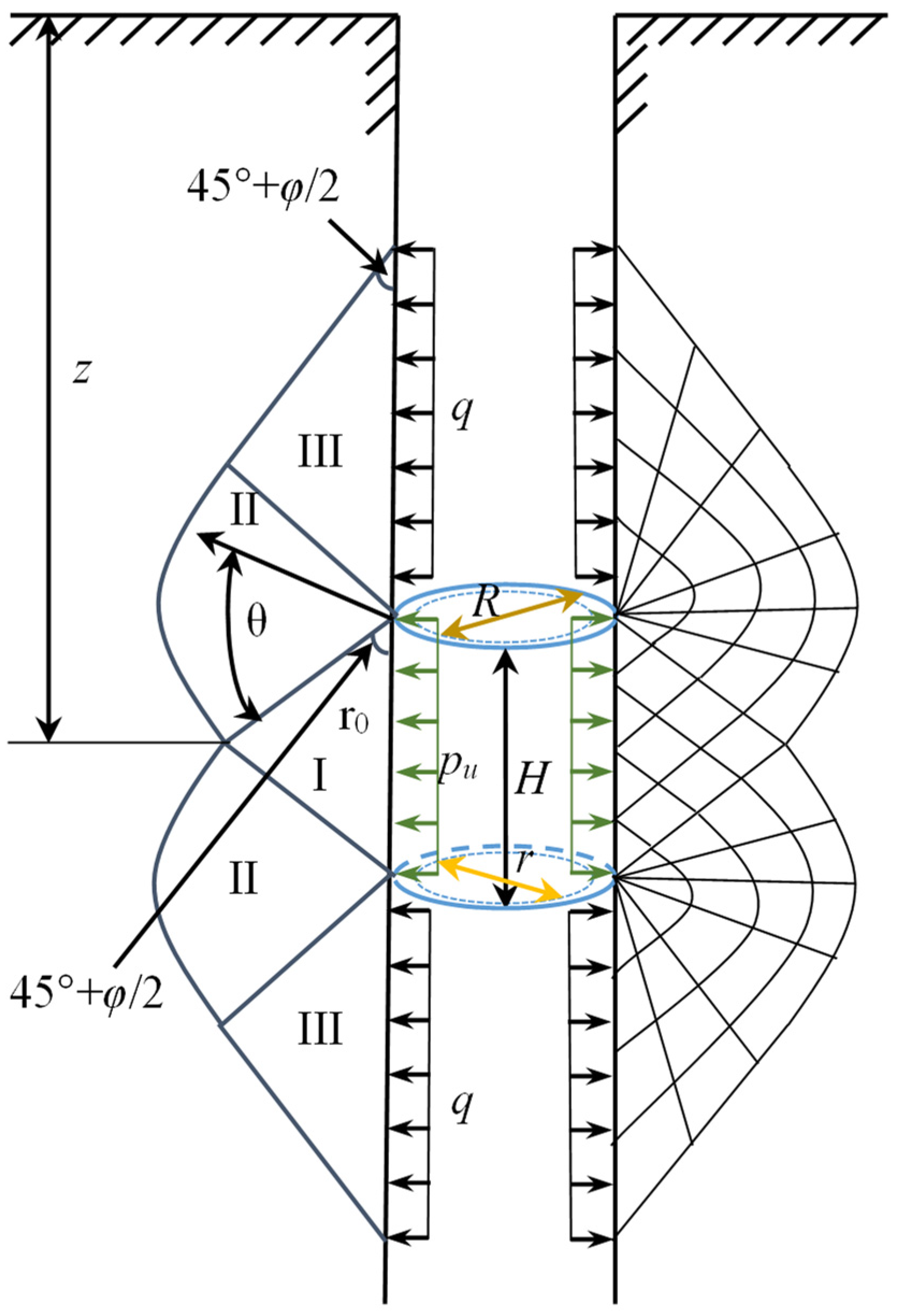

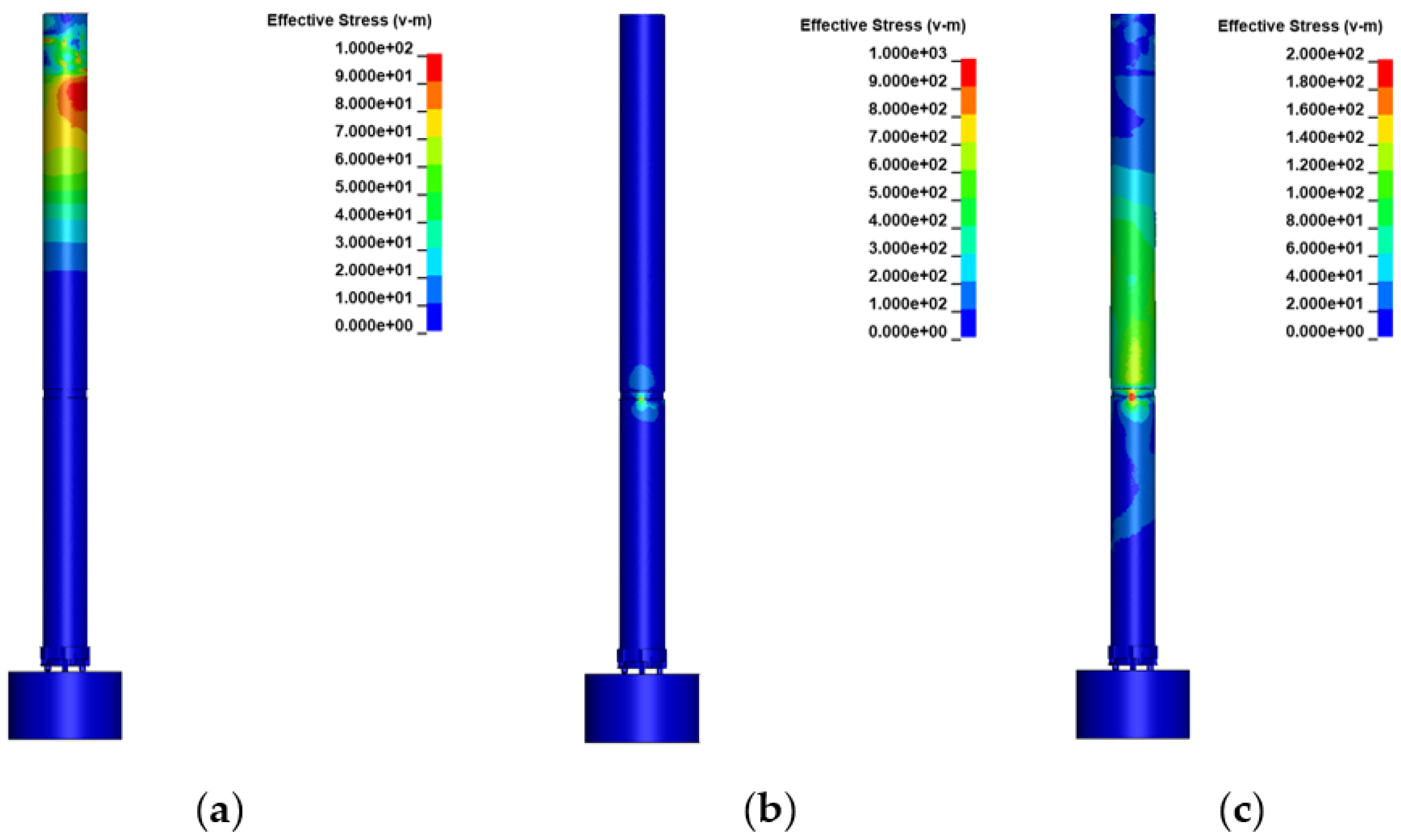

| Depths z (m) | Cohesion c (kPa) | Angle of Internal Friction φ (°) |
|---|---|---|
| 0~0.15 | 0.44~0.62 | 41~43 |
| 0~0.3 | 0.74~1.1 | 44~47 |
| 0.3~0.6 | 2.4~3.8 | 52~55 |
| 0~0.6 | 1.3~1.9 | 48~51 |
| Motor Torque Md (Nm) | Cam Stroke Height h (mm) | Preload Length l0 (mm) | Spring Stiffness k (N/m) | Proportion of the Loaded Segment α (%) | Impact Mass M (g) | Impact Frequency λ (Hz) |
|---|---|---|---|---|---|---|
| 0.84 | 8.75 | 5.75 | 40,000 | 95 | 190 | 10 |
| Density ρ (kg/m3) | Shear Modulus G (GPa) | Tensile Strength T (MPa) | Uniaxial Compressive Strength fc (MPa) | Cohesive Strength A | Pressure Hardening B | Strain Rate Coefficient C | Pressure Hardening Exponent N |
|---|---|---|---|---|---|---|---|
| 2164 | 4.437 | 1.107 | 70.27 | 0.79 | 1.6 | 0.007 | 0.61 |
Disclaimer/Publisher’s Note: The statements, opinions and data contained in all publications are solely those of the individual author(s) and contributor(s) and not of MDPI and/or the editor(s). MDPI and/or the editor(s) disclaim responsibility for any injury to people or property resulting from any ideas, methods, instructions or products referred to in the content. |
© 2023 by the authors. Licensee MDPI, Basel, Switzerland. This article is an open access article distributed under the terms and conditions of the Creative Commons Attribution (CC BY) license (https://creativecommons.org/licenses/by/4.0/).
Share and Cite
Wen, Y.; Zhang, G.; Xie, H.; Gao, M.; Zhang, X.; Wang, Y.; Li, C. Design and Dynamic Analysis of the Wire-Line Coring Robot for Deep Lunar Rocks. Appl. Sci. 2023, 13, 1722. https://doi.org/10.3390/app13031722
Wen Y, Zhang G, Xie H, Gao M, Zhang X, Wang Y, Li C. Design and Dynamic Analysis of the Wire-Line Coring Robot for Deep Lunar Rocks. Applied Sciences. 2023; 13(3):1722. https://doi.org/10.3390/app13031722
Chicago/Turabian StyleWen, Yufeng, Guoqing Zhang, Heping Xie, Mingzhong Gao, Xu Zhang, Yaohui Wang, and Cunbao Li. 2023. "Design and Dynamic Analysis of the Wire-Line Coring Robot for Deep Lunar Rocks" Applied Sciences 13, no. 3: 1722. https://doi.org/10.3390/app13031722
APA StyleWen, Y., Zhang, G., Xie, H., Gao, M., Zhang, X., Wang, Y., & Li, C. (2023). Design and Dynamic Analysis of the Wire-Line Coring Robot for Deep Lunar Rocks. Applied Sciences, 13(3), 1722. https://doi.org/10.3390/app13031722







